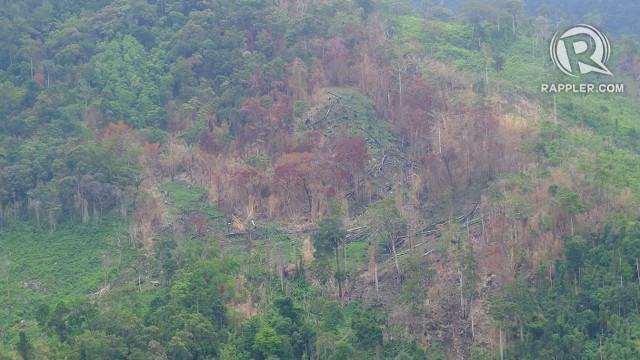News
Sarihay in Focus: “Rethinking the National Greening Program” by Pia Ranada
Posted on May 22, 2015(Tenth in an eleven-part series.)
In June 2014, reporter Pia Ranada posed an insightful question to readers of Rappler.com:
Is the government's reforestation program genuine reforestation or a perpetuation of the mindset that trees are commodities for humans to exploit?
“Rethinking the National Greening Program”, Ranada’s sobering examination of the government’s flagship reforestation effort is a piece that gives readers a closer look at the inner workings of the NGP. With her effort and insight, the author earned the Foundation for the Philippine Environment’s (FPE) Sarihay Media Award for Best Online Commentary.
A portion of the Ipo watershed where reforestation sites are regularly damaged by forest fires. (Pia Ranada/Rappler.com)
The article begins with an acknowledgement of the appeal of tree-planting as a popular measure for environmental conservation efforts. With that, it is indeed an easy decision to allot a huge some of the national budget to an initiative such as the NGP, which aims to mobilize billions of Pesos towards the planting of 1.5 billion trees across 1.5 million hectares by 2016.
“How could that ever be a bad thing for the environment?” Ranada muses.
She proceeds to bravely argue that a large sum allocated towards even a noble agenda such as large-scale reforestation is not always a guaranteed win.
Likewise, good numbers indicated in reports don’t always mean things are all good on the ground. According to the piece, while accomplishment reports on the NGP have turned in remarkable numbers, the actual situation on the reforestation sites are not necessarily as encouraging.
With helpful insight from vigilant environmentalist groups and officers of the Department of Environment and Natural Resources (DENR), the commentary uncovers various types of setbacks that provide a reality check for the supposedly positive numbers being associated with the NGP. Some of these, disturbingly, are caused by the very people who are supposed to uphold and benefit from the program.
As it turns out, there are ongoing schemes designed to work around the NGP design, which has a seemingly misguided mandate that both native/indigenous species as well as exotic cash crop species should be planted in designated reforestation sites. The inclusion of the latter to create “production areas”, Ranada points out, supports and perpetuates the destructive and extractive behavior that man has towards its forest resources.
Because some local residents and contractors are aware that there are sites dedicated for harvest and profit, they devise plans to maximize economic gain while compromising the true intended goal of the reforestation program. These involve “allowing ‘forest fires’” to regularly ravage planting sites in order to be able to ask for new contracts. Settlers and illegal loggers in the sites also massively extract forest resources for basic needs and livelihood, albeit perhaps far less conscious of the exploitable loopholes of the NGP.
(The same issue has been the focus of another Sarihay Media Award winner, Jun del Rosario’s TV news report on illegal logging in the Ipo watershed.)
“In the undying debate between economic development and environmental protection, is the NGP siding with the former?” muses Ranada.
The article, however, is not a hopeless critique of government’s efforts to revive its fast-shrinking forests. The NGP is not a lost cause. With vigilance and proactive involvement from concerned environmental groups – among which FPE is included – the program can still be carried out to a measurable extent of success.
However, as it approaches the tail-end of its duration, the NGP desperately needs additional factors to make sure it works properly and is effectively protected against exploitative parties for the long term. Aside from emphasizing the need for effective (adequately funded and staffed) forest patrol efforts, Ranada also made a call for an independent, objective, and credible “watchdog” that will monitor and evaluate the type, quality, state of the trees and seedlings being planted.
The full article is linked here.
* * * * *
The Sarihay Media Awards was launched last February 2014 in recognition of the important role of the media in promoting awareness and better understanding of environmental and sustainable development issues among policymakers, decision makers, and the public. The campaign served as both acknowledgement and reward to those who deliver outstanding and responsible reportage of environmental news. The term "Sarihay" comes from the Filipino phrase, "Samu't Saring Buhay", which aptly describes biodiversity.
Read More:
- Executive Director Dr. Jerome L. Montemayor carried the banner of the Foundation for the Philippine Environment and the larger civil society during the SBSTTA 26 and SBI 4 meetings in Kenya
- Call for Proposals for the SGP-8 Country Programme Strategy
- #Y4B Ambassadors: JOEPET JEROME S. JARO
- #Y4B Ambassadors: MELLARD MANOGURA
- #Y4B Ambassadors: MARY JANE P. MAGAN
- #Y4B Ambassadors: SHRI TAHANIE B. MACAUMBAO

 DISPLAY CALENDAR
DISPLAY CALENDAR

 Read Policy Briefs
Read Policy Briefs
 View Our Partners
View Our Partners
 Access Grants MIS
Access Grants MIS
 Login to Webmail
Login to Webmail